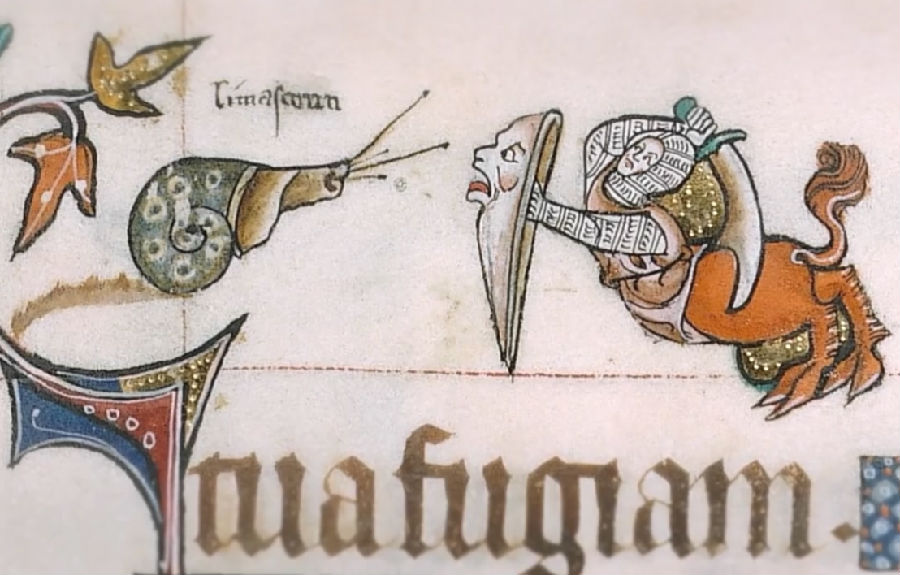(单词翻译:单击)
We’ve all been there: after a long day at work, you sit down and binge-read some Arthurian romances.
我们都有过这样的经历:工作了一整天,我们坐下来沉浸在关于亚瑟王的一些浪漫传奇中。
They’re called “illuminated manuscripts” - because they’re illuminated with illustrations in the borders, colorful drawings, and very … special doodles in the margins.
这些书也叫“绘本”——因为书页四周绘有彩色插图和有趣的涂鸦。
But among all those steroidal rabbits and this hooded person laying literal eggs, there’s actually a theme...
然而,画里这些诡异的兔子,戴着头巾正在下蛋的人,这些绘画里其实贯穿了一个主题:
A lot of medieval knights in these manuscripts are...fighting snails.
这些绘本反复出现了中世纪骑士与蜗牛打斗的场景。
Why is this happening?
这是为什么?
The largest snail alive is 15.5 inches, snout to tail.
现今存活的蜗牛最长也不过0.4米,还是触角到尾巴整个的长度。
So why does this knight look like he’s in for the fight of his life?
那为什么这位骑士看上去还打斗得很吃力?
Illuminated manuscripts were handwritten.
绘本都是手工绘制的。
Scribes painstakingly transcribed the same bibles, devotionals, and stories.
抄写员们耗费大量的精力誊写《圣经》,宗教宣传手册以及小说。
They also decorated the margins.
顺便修饰一下书页的天头地脚。
By the 1960s, one scholar thought those margins were worth attention.
到上个世纪六十年代,一位学者发现,这些天头地脚也值得关注。
Lillian Randall was particularly intrigued by “The Snail in Gothic Marginal Warfare.”
莉莉安·兰德尔对“哥特式旁注大战中的蜗牛”尤其感兴趣。
She developed a theory about why a book like this might include a winged knight fleeing snails.
她还专门提出了自己的理论,讨论这样的一本书里为何会有带翅膀的骑士逃避蜗牛的追击,
And why it showed up again and again and again.
以及为什么这一画面会一而再再而三地出现这样的问题。
Randall found more than 70 snail-fighting heroes in just 29 manuscripts, most of which were made between 1290 and 1310.
兰德尔发现,她研究的29本绘本,大部分都于1290年到1310年间绘制,就出现了70次骑士大战蜗牛的场面。
Pray for yourself, knight. Pray that the snail will kill you quickly.
自求多福吧骑士,赶紧祈祷蜗牛杀你的时候给你个痛快吧。
Sometimes the margins riffed on the text, sometimes they were disconnected.
这些脚注有的和故事内容交相呼应,有的则与内容完全无关。
But Randall connected them to historical stereotypes.
然而,兰德尔认为这些脚注与某些历史观念有关。
The biggest was that the “Lombards” were greedy, mean, and cowardly.
其中,最典型的是贪婪小气又懦弱的“伦巴底人”。
The Lombards were a Germanic people that had invaded Italy. They were warriors.
伦巴底人是一个日耳曼民族,他们的人都很勇猛,曾经入侵过意大利。
But in 772, they were badly beaten by Charlemagne.That permanently stained their reputation.
然而,772年,他们被查理曼大帝打得落花流水,他们的荣誉也由此抹上了永久的污点。
By the late 1200s — when those snail pictures started getting popular —
到了十三世纪晚期——也就是那些蜗牛绘画开始流行的时候——
the Lombards had become lenders and pawnbrokers spread throughout Europe.
伦巴底人开始在欧洲各地放债,开当铺。
They didn’t have full rights, they couldn’t even own arms. But they did have power.
他们没什么权利,连持有武器的权利都没有。但他们有势力。
That combination of power and impotence, Randall argued, made them targets.
正因为如此,按照兰德尔的说法,他们才成了被攻击的目标。
“Snail” was the appropriate insult.
“蜗牛”就是对它们恰切的嘲讽。
Snails carried their houses on their backs as they retreated, just as the Lombards had from Charlemagne.
因为蜗牛逃命都背着它们的壳的情形,简直和伦巴底人逃离查理曼大帝追击时一模一样。
They were slimy, like a lot of Europeans probably saw their lenders.
蜗牛很滑,很多欧洲人可能也是这么看他们的债主的。
Calling Lombards snails was an anti-foreign slur that later grew into a bigger trope.
把伦巴底人比喻成蜗牛本就是带有排外性质的诽谤,后来还演变成了更大的隐喻。
It appeared in what was probably a medieval pattern book, with models that helped other scribes draw.
一本类似于中世纪样本——内有教其他作者如何绘制绘本的模型——的书都采纳了蜗牛的这一形象。
And snails showed up in many different combinations later on.
后来,蜗牛就以各种形式反复出现在了中世纪绘本里。
Here’s a snail/monkey/rabbit battle royale from the 1400s.
比如这个十五世纪绘本中的蜗牛/猴子/兔子大战。
Snails were slow. But they spread.
蜗牛行动迟缓,但它们依然能够前进。
We can’t be certain what the knights and snails meant because they meant different things as the image became a cliche.
我们无法弄清这些骑士和蜗牛的真正含义,因为随着这一形象逐渐变成老生常谈的问题,人们对它们的解读也会发生变化。
The same way people don’t explain their memes today, scribes didn’t annotate their games in the margins.
人们无法解释他们的含义,抄写员们也没有在注释里解释蜗牛和骑士之间的战争。
Randall’s argument fits with the timing and history.
兰德尔的解释符合当时的时代背景和历史背景。
But people also speculate that snails represented the slowness of time, or the insulation of the ruling class.
但也有人猜测,蜗牛代表的是当时时代发展的缓慢,或者与当时统治阶级的隔阂。
We can only be certain about one thing, the snails reveal something, along with everything else in the margins.
唯一能确定的是,那些蜗牛和旁注里的其他内容一样,都是有意义的。
As scribes labored over transcriptions of hallowed works, reproducing every line, they snuck in additions, jokes, and riffs, in the margins of the text.
抄写员们费尽心思誊抄这些神圣的作品,逐行逐行解读其中的内容,同时偷偷在旁边插入一些补充、笑话或即兴重复段。
The drawings were fantasies. But they were made by artists who sought to parody the indignities and absurdities of their own world.
这些绘画的内容天马行空,但都是画家们用来戏仿他们那个屈辱而荒谬的时代的。
The margins were the only space left. So they turned them into a self-portrait.
书角是书里唯一空白的地方,所以画家们就把它们变成了他们的自画像。
Except for this guy. He’s just going to get murdered by a snail.
除了这个家伙,因为他马上就要死在蜗牛手里了。
So this video just scratches the surface when it comes to weird medieval art and possible interpretations.
本期视频只是隔靴挠痒般地给大家介绍了一下中世纪奇怪的艺术以及可能的解读。
Michael Camille wrote a whole book about art in the margins and he highlights one figure:
迈克尔·卡米尔有一本介绍旁注中的绘画的专注,他还特别提到了其中一个形象:
it’s the gryllus, and he’s supposed to represent bodily appetites. It’s very cute and a little disgusting.
就是代表肉体欲望的葛利勒,这幅画挺漂亮的,就是有点儿恶心。


